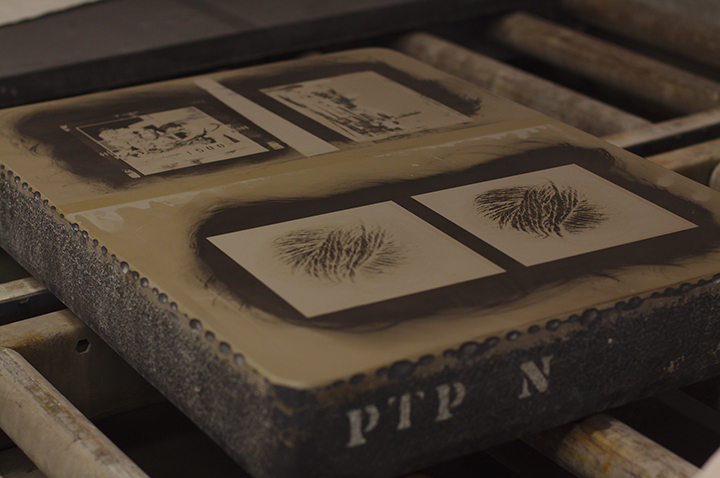M.F.A. printmaking student Christopher Hagen has used a Friends of the Arts grant to bring stone photolithography techniques and materials to Illinois State University.
Hagen, a printmaker from Spooner, Wisconsin, attended a workshop last summer at the Tamarind Institute in Albuquerque, New Mexico, to better learn about stone photolithography so he could teach Illinois State students the technique and incorporate it into his practice. He also will be sharing his research in an open presentation April 11 at the University Research Symposium.
Hagen recently talked about the process, his work, and the importance of the grant in the following Q-and-A.
Why did you become an artist?
I found my way in through photography back in high school. I was largely focused on the sciences and literature in high school, but I couldn’t really, clearly see where my future would be in those fields directly. I ended up finding my way from basic ceramics classes and what art program we had to photography, which got me into the darkroom, and I got interested in both documentary aspects of that, and environmental or social, and then just in the process of it, and that’s when it started to go down that path. I found my way into the more scientifically oriented, or at least technically oriented, arts. I was able to bring together thinking about the sciences and general culture and social change, if possible, and then bringing that together with aesthetic interests.
Why did you come to Illinois State University?
I was in Minneapolis at the time, at the Highpoint Center for Printmaking as an intern in a professional studio. I met Lisa Lofgren, M.F.A. ’12, who introduced me to the program. I came to visit after I applied, and it felt like the right fit in general. And I had the additional surprise that some of the prints that I had been around when I worked at the museum in Duluth—the Tweed Museum of Art—came from the professional studio here, Normal Editions Workshop.
Tell me about the process of stone photolithography that you used for the Friends of the Arts grant project?

Christopher Hagen separates egg albumen for coating a stone at the Tamarind Institute. (Photo by Sarah Marshall)
Basically, because I came from photo into the rest of my art making world, I didn’t necessarily have a very strong drawing background, which I’ve been working to catch up. So for me thinking photographically and generally working from my photos, it made sense. While I was pouring through the older manuals of litho in undergrad, I came across this process as it was the origin of photo-printmaking. Nowadays we use commercial, prepared plates that are pretty much the same as the commercial printing industry. That’s a very off the shelf, here you go, shell out some money, buy a product, if it doesn’t work, throw it away, and start again. Whereas when you work with a stone and you have processes of getting images on the stone, you can re-grain the stone repeatedly.
So through that, I stumbled across the old, original technique, which plenty of people out there still practiced, but it’s sure not taught at most programs. I started working with that. And it’s basically as raw and basic as you get in terms of handling material. It’s like going straight back into chemistry. You take egg whites and you put ammonium dichromate in it, you put some sort of photo sensitive salt into it. And when it gets exposed to light, it hardens. So your image gets basically affixed to the stone from a negative just like in darkroom photography. And then that will be what will take ink; that will actually become the image that you are making. The other benefit though to doing it on the stone, you can draw back into the image after you’ve put the photo down.
That suits the way that I work now: often sampling little elements of photographic imagery. I’ve been exploring between that and more purely photographic and more purely hand-rendered work in my time here. Now I’m working towards bringing them together again, bringing in the elements of my photography into the work. And it can be accessible as either printing a negative from a digital photograph, or one of the students in last semester’s Intro to Litho class was in photo classes and they were finding their way with drawn imagery as well. One of the main hopes of this grant is to engage photography students and graphic design students that maybe don’t feel that much of a connection with the traditional stone techniques and be able to get some graphic or photographic imagery onto their stone. Instead of just discarding that experience for the commercial plates, they can keep working with something hands-on but getting something closer to their real way of working onto it.
Why are Friends of the Art grants important?
Without the grant, it would have taken me my entire time here to just fund getting the materials. Part of the grant eased my way of being able to afford the workshop I went to over the summer where I was able to get some one-on-one instruction with the guy (Rodney Hamon) that writes the books, basically the people that prepare the manuals for us. Basically it completely short-cutted what would have been a three-year venture to get it to the point where it could be offered to students.

